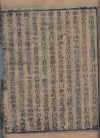Information About Chopmarking Foreign Silver Coins Mentioned in An Early Chinese Publication
Recently, I read a book series titled "Overview of Silver
Varieties" which was published in 1826 (Tao Kuang 6th year). It mentions some important information about the practice
of chopmarking coins in China.
In volume 3, it is indicated that the Carolus III and IV Portrait Dollar were
called "Da Yi" in Chinese, which means "Big Dress" (Fig.1);
while the Ferdinand VII Portrait Dollar was called "Hsiao Yi", which
means "Small Dress" (Fig.2). Obviously, the Chinese noticed the
difference in the size of the Spanish kings' robes shown on the coins, therefore, two Chinese names were given.
There is a passage on the chopmarking of "Big Dress" and "Small
Dress" coins (Fig.3) which is very informative and is translated as
follows:
"...Those being circulated in Suchow (one of the major cities of Jiangsu
Province, and in the vicinity to Shanghai) have been stamped with
chopmarks the size of an ant's mouth. The reason is Suchow always uses
small chopmarks or ink chops with an intention of not hurting the coins.
There is a kind of "Big Dress" in a light weight of about 6.4-6.5
maces which carries numerous chopmarks, which are prevailing in Wu Yi of the
Fujien Province; the Fujien merchants are accustomed to using these coins to pay
for tea and paper, so the chopmarks are also called the "Tea Chops" or
"Paper Chops". Sometimes the coins have been chopped so repeatedly
their surface details are almost lost, only III or IV can be
recognized...."
The light-weight Portrait Dollars which circulated in Fujien had lost silver (and weight) because
they had been so heavily stamped with big chops. This
has confirmed our assumption that Type I Chopmarks (the small ones) were
used on coins which circulated in Shanghai and its vicinity, and Type II
Chopmarks (the big ones) were applied from the 1800's in the Kuangtung and
Fujien regions. (See: "Foreign
Silver Coins and Chinese Sycee" and "Chopmarked
Coins of the Late 19th & Early 20th Century")
"Overview of Silver Varieties" also warns its readers not to punch a
chopmark on top of any chopmark which looked like it had been newly stamped by
the former owner of the coin, otherwise, he may refuse to guarantee the
authenticity of the coin for the reason that his chopmark can no longer be
recognized.
Return to Chopmarked Foreign Silvers


